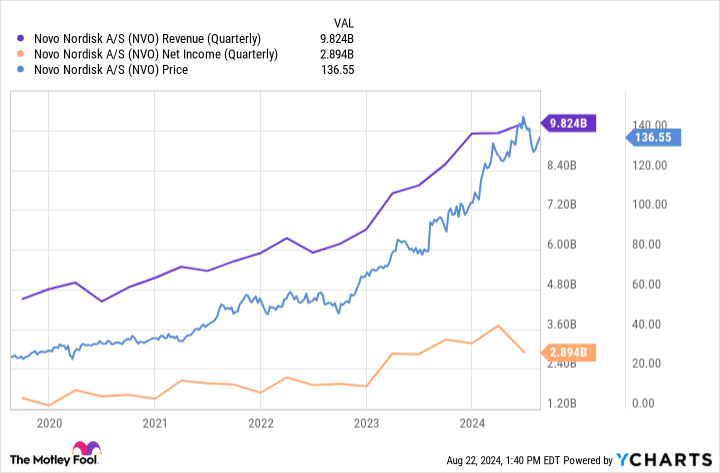Why Viking Therapeutics Stock Got Thrashed on Tuesday
News from a deep-pocketed rival put the hurt on biotech Viking Therapeutics‘s (NASDAQ: VKTX) stock on Tuesday. Said rival seems determined to dominate a very hot therapeutic area these days, and it might be tough for a relatively small fry like Viking to compete. On the back of such worries, investors sold out of the biotech, sending its share price down by more than 6% across the trading session. That was on a good day for stocks, generally, with the S&P 500 index inching up by 0.2%.
A discount offering rocks the obesity drugs segment
That giant competitor is Eli Lilly (NYSE: LLY), which on Tuesday announced that its Zepbound weight loss drug would be made available to patients in single-dose vials containing either 2.5 milligrams or 5 milligrams of the product. According to the pharmaceutical giant, the price for these new offerings is at least 50% cheaper than that of competing GLP-1 treatments for obesity.
“This new option helps millions of adults with obesity access the medicine they need, including those not eligible for the Zepbound savings card program, those without employer coverage, and those who need to self-pay outside of insurance,” Eli Lilly said in the press release touting the new dosages.
This affects Viking because the biotech is approaching the final stages of development of its own weight-loss drug. This will soon be put through its paces in a phase 3 clinical trial.
The right products for the right market
As GLP-1 drugs offer the tantalizing possibility of weight loss without exercise, they have become wildly popular in the U.S. — a country with a great many overweight individuals. There are very few approved obesity drugs on the market, hence Eli Lilly’s clear attempts at establishing an early toehold in the segment. Viking certainly has its work cut out for it if and when its own weight loss products make it to pharmacy shelves.
Should you invest $1,000 in Viking Therapeutics right now?
Before you buy stock in Viking Therapeutics, consider this:
The Motley Fool Stock Advisor analyst team just identified what they believe are the 10 best stocks for investors to buy now… and Viking Therapeutics wasn’t one of them. The 10 stocks that made the cut could produce monster returns in the coming years.
Consider when Nvidia made this list on April 15, 2005… if you invested $1,000 at the time of our recommendation, you’d have $774,894!*
Stock Advisor provides investors with an easy-to-follow blueprint for success, including guidance on building a portfolio, regular updates from analysts, and two new stock picks each month. The Stock Advisor service has more than quadrupled the return of S&P 500 since 2002*.
*Stock Advisor returns as of August 26, 2024
Eric Volkman has no position in any of the stocks mentioned. The Motley Fool has no position in any of the stocks mentioned. The Motley Fool has a disclosure policy.
Why Viking Therapeutics Stock Got Thrashed on Tuesday was originally published by The Motley Fool
If You'd Invested $10,000 in Berkshire Hathaway Stock 10 Years Ago, Here's How Much You'd Have Today
Just about everyone who might read this article probably knows that Warren Buffett, CEO of Berkshire Hathaway (NYSE: BRK.A) (NYSE: BRK.B), has been a phenomenal investor — for decades. He displays his company’s growth and performance over the years in each annual report, and per the last one (for 2023), the overall gain from 1965 to 2023 was 4,384,748%. Yes, that’s 4.3 million! Annualized, it’s 19.8% per year. Of course, few of us invested in this amazing company way back in 1965.
So what would you have now if you’d invested $10,000 in Berkshire Hathaway just 10 years ago? Well, the answer might surprise you: You’d have $31,797 — which is 12.26% annually, on average. If you’re disappointed, know that you’d still be ahead of the S&P 500 — which averaged 11.61% over the same period.
Berkshire is simply growing more slowly in recent years, in part because it has grown so big. Its market value was recently $950 billion. Buffett is sitting on some $277 billion in cash, much of which he can deploy by buying more businesses, but he’s picky, insisting on high quality and a reasonable valuation.
Should you invest in Berkshire Hathaway now? Well, don’t do so if you’re looking for annual gains in the 20% range year after year. The stock is up about 23% year to date as of this writing, but its three-year average is 15%, and it may average only 8% or 10% over the next few years. No one knows.
But if you’re looking for a solid investment that’s very likely to grow over time, do consider the stock. Berkshire is a big conglomerate, with a wide range of businesses — including insurance, energy, homebuilding, jewelry, candy, transportation, and much more. And it owns a lot of stock in other companies — recently 21% of American Express, 9% of Coca-Cola, 2.5% of Apple, and nearly 12% of Bank of America.
Should you invest $1,000 in Berkshire Hathaway right now?
Before you buy stock in Berkshire Hathaway, consider this:
The Motley Fool Stock Advisor analyst team just identified what they believe are the 10 best stocks for investors to buy now… and Berkshire Hathaway wasn’t one of them. The 10 stocks that made the cut could produce monster returns in the coming years.
Consider when Nvidia made this list on April 15, 2005… if you invested $1,000 at the time of our recommendation, you’d have $792,725!*
Stock Advisor provides investors with an easy-to-follow blueprint for success, including guidance on building a portfolio, regular updates from analysts, and two new stock picks each month. The Stock Advisor service has more than quadrupled the return of S&P 500 since 2002*.
*Stock Advisor returns as of August 26, 2024
American Express is an advertising partner of The Ascent, a Motley Fool company. Bank of America is an advertising partner of The Ascent, a Motley Fool company. Selena Maranjian has positions in American Express, Apple, Bank of America, and Berkshire Hathaway. The Motley Fool has positions in and recommends Apple, Bank of America, and Berkshire Hathaway. The Motley Fool has a disclosure policy.
If You’d Invested $10,000 in Berkshire Hathaway Stock 10 Years Ago, Here’s How Much You’d Have Today was originally published by The Motley Fool
This Stock-Split Stock Could Soar If Nvidia Delivers a Blowout Q2 Update
Which company is the center of attention this week? It’s Nvidia (NASDAQ: NVDA), hands down. The chipmaker will announce its second-quarter earnings results following the market close on Wednesday.
I fully expect Nvidia’s numbers to delight investors again, enabling it to extend its already impressive gains this year. But there’s another stock-split stock that could also soar if Nvidia delivers a blowout Q2 update.
Joined at the hip
Super Micro Computer (NASDAQ: SMCI), also called Supermicro, is arguably joined at the hip with Nvidia. The company provides server and storage solutions that are especially popular in data centers.
The same artificial intelligence (AI) tailwind fueling Nvidia’s growth also helps Supermicro. Charles Liang, Supermicro’s president and CEO, said earlier this month that his company “continues to experience record demand of new AI infrastructures.” As a result, Supermicro’s revenue in the fourth quarter of its fiscal 2024 soared 110% year over year.
If Nvidia handily beats expectations with its Q2 results on Wednesday (and, more importantly, if the company’s guidance is strong), it will bode well for Supermicro’s fortunes over the near term. I look for Nvidia to also provide some clarity on the timing of when chips based on its new Blackwell architecture will begin shipping. This should also help Supermicro, which has liquid-cooled AI superclusters ready to support Blackwell.
Sure, Liang maintains that a delay for Blackwell won’t impact Supermicro much because it does business with other chipmakers. Make no mistake about it, though: Good news from Nvidia will translate to good news for Supermicro.
Will Supermicro’s stock split provide another catalyst?
I don’t think there’s much doubt that a blow-out Nvidia Q2 update would provide a catalyst for Supermicro. But what about the company’s 10-for-1 stock split scheduled for Oct. 1? It’s iffy, in my view.
For one thing, Supermicro’s stock split won’t change anything at all about the company’s underlying business or its growth prospects. On the other hand, spectacular guidance from Nvidia would likely mean stronger growth ahead for Supermicro.
Any investor who really wanted to buy shares of Supermicro could do so even with its share price trading in the ballpark of $600. Many online brokerages support buying fractional shares.
However, this will be Supermicro’s first stock split. I’ll admit that it’s possible some investors who have remained on the sidelines could view the split as a great opportunity to buy the stock. I suspect the allure to invest in Supermicro could be even greater if the stock indeed soars as I expect it will following Nvidia’s quarterly update this week.
Is Supermicro a better stock to buy than Nvidia?
Now for an even more important question: Is Supermicro a better stock to buy than Nvidia? Wall Street seems to think so.
The consensus 12-month price target for Supermicro of analysts surveyed by LSEG in August reflects an upside potential of over 50%. By comparison, the average price target for Nvidia is slightly lower than its current price.
I agree that Supermicro is a better pick than Nvidia. My primary reasoning is valuation. Supermicro’s shares trade at a much lower forward earnings multiple than Nvidia’s. But if Nvidia gives great news to investors on Wednesday, both of these stocks should be big winners.
Should you invest $1,000 in Super Micro Computer right now?
Before you buy stock in Super Micro Computer, consider this:
The Motley Fool Stock Advisor analyst team just identified what they believe are the 10 best stocks for investors to buy now… and Super Micro Computer wasn’t one of them. The 10 stocks that made the cut could produce monster returns in the coming years.
Consider when Nvidia made this list on April 15, 2005… if you invested $1,000 at the time of our recommendation, you’d have $792,725!*
Stock Advisor provides investors with an easy-to-follow blueprint for success, including guidance on building a portfolio, regular updates from analysts, and two new stock picks each month. The Stock Advisor service has more than quadrupled the return of S&P 500 since 2002*.
*Stock Advisor returns as of August 26, 2024
Keith Speights has no position in any of the stocks mentioned. The Motley Fool has positions in and recommends Nvidia. The Motley Fool has a disclosure policy.
This Stock-Split Stock Could Soar If Nvidia Delivers a Blowout Q2 Update was originally published by The Motley Fool
Billionaire Stanley Druckenmiller Goes Bargain Hunting: 2 Stocks He Just Bought
Stanley Druckenmiller might not be as well known as some other hedge fund billionaires, but if you’re looking to learn from the best, it’s hard to do better than Druckenmiller.
A protege of George Soros, Druckenmiller helped make the famous bet with Soros that broke the Bank of England, crashing the British pound and making more than $1 billion in 1992.
Even better, as the manager of Duquesne Capital Management, Druckenmiller has generated a compound annual average return of 30% from the fund’s founding in 1981 to its closure in 2010. Druckenmiller continues to invest through his family office, and his moves are closely followed. Druckenmiller stresses position sizing in his strategy, saying, “It’s not whether you’re right or wrong; it’s how much you make when you’re right and how much you lose when you’re wrong.” He’s also known for following macro trends, and being quick to change his mind as situations change.
So what was Druckenmiller buying in the second quarter? Let’s take a look at a couple of his most intriguing buys.
1. Philip Morris
One of Duquesne Capital Management’s biggest new positions in the quarter was Philip Morris International (NYSE: PM), the international tobacco giant.
Duquesne bought nearly 900,000 shares in Philip Morris, worth roughly $110 million. It also bought calls in the stock, indicating even more bullishness on the tobacco asset. Druckenmiller’s bet appears to have paid off as the stock has jumped by more than a third since its bottom on April 12, a big move from a recession-proof industry known for dividends and safety.
Philip Morris stock has broken out as the company has been more successful at pivoting to smoke-free products than peers like Altria and British American Tobacco. In fact, roughly 40% of Philip Morris’ revenue now comes from next-gen products like Zyn nicotine pouches and Iqos heat-not-burn devices. It even acquired the license to sell Iqos sticks in the U.S., opening up a potentially large market for the smoke-free product.
In its second quarter, Philip Morris saw solid growth with organic revenue up 9.6% to $9.5 billion and a 10.6% increase in adjusted earnings per share of $1.77. Growth from its smoke-free categories was even more impressive as organic revenue rose 18% and gross profit was up 22%. As smoke-free products make up more of the business, it should drive increased revenue growth.
Philip Morris also remains a strong dividend stock with a dividend yield of 4.3%.
2. Coherent
Druckenmiller’s biggest holding is now Coherent (NYSE: COHR), which comes after he sold a significant stake in Coupang and sold most of his shares of Nvidia.
Coherent makes lasers and develops laser-based technology and electro-optic switches. Its technology has become valuable in semiconductor manufacturing, which has connected the company to the artificial intelligence (AI) boom.
The company is seeing strong growth in its Datacom transceiver business, a key part of fiber-optic networks, which is being driven by growth in generative AI. That also helped expand Coherent’s gross margin in the quarter, which rose 440 basis points to 32.9%.
Wall Street expects profits to continue to ramp up as it capitalizes on the emerging technology. Coherent’s own guidance calls for adjusted earnings per share of $0.53 to $0.69, up from just $0.16 in the quarter a year ago, while revenue is expected to grow 24.7% at the midpoint of its guidance range of $1.27 billion to $1.35 billion.
Like Philip Morris, Coherent also rallied in the second quarter, jumping more than 50% from its low point in April.
Druckenmiller was early to invest in Nvidia after ChatGPT launched, buying that stock in the fourth quarter of 2022, so he has sharp insight into the artificial intelligence industry, and that could explain his aggressive bet on Coherent. The laser technology company is an under-the-radar AI stock and could be a long-term winner if it can continue to ramp up profits.
Should you invest $1,000 in Philip Morris International right now?
Before you buy stock in Philip Morris International, consider this:
The Motley Fool Stock Advisor analyst team just identified what they believe are the 10 best stocks for investors to buy now… and Philip Morris International wasn’t one of them. The 10 stocks that made the cut could produce monster returns in the coming years.
Consider when Nvidia made this list on April 15, 2005… if you invested $1,000 at the time of our recommendation, you’d have $792,725!*
Stock Advisor provides investors with an easy-to-follow blueprint for success, including guidance on building a portfolio, regular updates from analysts, and two new stock picks each month. The Stock Advisor service has more than quadrupled the return of S&P 500 since 2002*.
*Stock Advisor returns as of August 26, 2024
Jeremy Bowman has no position in any of the stocks mentioned. The Motley Fool has positions in and recommends Coupang and Nvidia. The Motley Fool recommends British American Tobacco P.l.c., Coherent, and Philip Morris International and recommends the following options: long January 2026 $40 calls on British American Tobacco and short January 2026 $40 puts on British American Tobacco. The Motley Fool has a disclosure policy.
Billionaire Stanley Druckenmiller Goes Bargain Hunting: 2 Stocks He Just Bought was originally published by The Motley Fool
Forget Amazon And Tesla. This Non-Magnificent Seven Stock Is Soaring.
While it doesn’t earn the Magnificent Seven moniker, Costco Wholesale (COST) has outpaced all of those tech titans this year, except Nvidia (NVDA) and Meta Platforms (META). Plus, the performance of Costco stock has more than doubled that of Amazon.com (AMZN) and Tesla (TSLA) — and tripled that of Microsoft (MSFT) — since January. Now the big box retailer is expanding that lead with a fresh breakout.
↑
X
Hone Your Stock Market Investing Skills With IBD Meetup Groups
Costco Smashing Amazon, Tesla, Microsoft This Year
With Nvidia set to report today after the close, Wall Street eagerly awaits what one analyst called the “most important tech earnings in years.” Nvidia stock has already delivered the best performance among the Magnificent Seven stocks this year with a 159% gain as of Tuesday’s close.
Meta Platforms is next, up 47% this year.
But then comes non-Magnificent Seven company Costco, which has delivered a 38% year-to-date gain as of Tuesday’s close. The big box retailer doesn’t just top Alphabet, Apple, Tesla, Amazon and Microsoft. It more than doubles all of them. Costco has even more than tripled the 10% gain for Microsoft stock while Tesla is actually down 16% for the year.
And to add insult to injury, as Amazon, Tesla and Microsoft remain mired below their 50-day moving averages, Costco has just joined the IBD Breakout Stocks Index as it launches a move to fresh highs.
| Company | Symbol | % Gain YTD* | Comp Rating | EPS Rating | RS Rating | SMR Rating |
|---|---|---|---|---|---|---|
| Nvidia | NVDA | 159% | 97 | 99 | 98 | A |
| Meta Platforms | META | 47 | 93 | 97 | 91 | A |
| Costco Wholesale | COST | 38 | 92 | 89 | 91 | B |
| Alphabet | GOOGL | 18 | 74 | 98 | 61 | A |
| Apple | AAPL | 18 | 90 | 86 | 86 | A |
| Amazon.com | AMZN | 14 | 76 | 81 | 55 | A |
| Microsoft | MSFT | 10 | 62 | 93 | 52 | A |
| Tesla | TSLA | -16 | 52 | 57 | 38 | B |
*As of Aug. 27, 2024
See Who Joins Costco On The IBD Breakout Stocks Index
Costco Stock Shops For A Breakout — And Finds One
With its relative strength line already hitting a 52-week high, Costco stock popped into buy range this week, where it remains. The retail giant cleared an 896.67 buy point in an early stage cup pattern and currently trades 1% above that entry.
While never a highflying and flashy growth stock in the vein of Nvidia, Meta or Tesla, Costco has a long track record of delivering solid and steady growth. Boosted by its reliable and recurring membership fees, the retailer has posted sales growth ranging from 2% to 15% over the last eight quarters.
In its latest quarterly report on May 30, Costco generated $58.5 billion in revenue, marking a 9% year-over-year gain.
Bottom-line growth has ranged from 4% to 18% over the last eight quarters. In the May report, Costco drove a 10% rise in earnings to $3.78 per share for the quarter.
IBD Breakout Opportunities ETF
The IBD Breakout Opportunities ETF (BOUT) from Innovator Capital Management tracks the IBD Breakout Stocks Index. As with other index ETFs, this fund allows you to invest in the entire index in addition to, or rather than, buying individual stocks. Learn more here about the ETF and Innovator.
Follow Matthew Galgani on X (formerly Twitter) at @IBD_MGalgani.
YOU MAY ALSO LIKE:
Nvidia Stock Faces Two Tests This Week. Investors Face A Third.
Microsoft, Nvidia Shunned. Meet The New Big ‘Daddy’ On Wall Street.
Step Aside, Tesla. This Stock Wants Your Mag 7 Card.
Generate New Stock Ideas With IBD Stock Screener
Identify Bases And Buy Points With This Pattern Recognition Tool
Ozempic Could Have a Terrible Side Effect. Is Novo Nordisk in Trouble?
The diabetes medicine Ozempic has been a veritable cash cow for Novo Nordisk (NYSE: NVO). The company’s revenue, earnings, and stock price have been on a tear in recent years — and no single drug has contributed more to its performance than Ozempic.
However, various potential headwinds have popped up that could disrupt Ozempic’s progress. One of them is competition. Novo Nordisk’s longtime foe in the diabetes market, Eli Lilly, developed Mounjaro, a diabetes medicine whose sales are growing incredibly fast.
Elsewhere, the side effects of Novo Nordisk’s crown jewel have come under increased scrutiny, and a recent study suggests that Ozempic could have a dangerous safety issue. Let’s look at what it could mean for Novo Nordisk.
Could Ozempic cause suicidal thoughts?
One of Ozempic’s side effects that has generated quite a bit of attention is muscle loss. However, an even more dangerous potential drawback that some researchers have warned about is the possibility that Ozempic could increase suicidal thoughts.
A recent study claims to shed more light on this topic. The study looked at two medicines in the GLP-1 receptor agonist class, to which semaglutide, the active ingredient in Ozempic, belongs. The other GLP-1 medicine featured was liraglutide, the generic name for Victoza and Saxenda, which treat diabetes and obesity, respectively.
Liraglutide was another one of Novo Nordisk’s discoveries. Through a database from the World Health Organization that tracks suspected adverse reactions from medicines and vaccines, the researchers found that Ozempic was associated with a higher rate of reported suicidal thoughts compared to other drugs. Liraglutide did not seem to be linked with higher rates of suicidal thoughts.
What should investors make of these findings? Should you sell the healthcare stock?
No reason to hit the panic button
Regulatory authorities are already aware of the potential association between Ozempic — or at least its active ingredient, semaglutide — and suicidal thoughts. Wegovy, an obesity medicine that shares this same active ingredient, has a warning for precisely that in the U.S.
Researchers sometimes learn even more about a therapy and its side effects after years of use in real-life settings. If studies establish a robust causal link between Ozempic or Wegovy and suicidal thoughts, that could cause regulators to take action. Perhaps they would add additional warnings or, in the worst-case scenario, take the medicine off the market. Either way, it would mean lower (or nonexistent) sales for Novo Nordisk’s biggest growth driver, dragging down its revenue, earnings, and stock price.
But there’s no reason to think this study will lead to that morbid scenario. Other studies have reached different conclusions. One published in Nature Medicine, one of the world’s most prestigious science journals, found that semaglutide had a lower risk of producing suicidal thoughts than other non-GLP-1 anti-obesity medicines in real-life settings. This study, unlike the previous one, compared patients based on factors that can influence suicidal behavior, including sex, socioeconomic status, ethnicity, and mental health.
It would take a lot to reverse these findings. So, for now, investors can continue focusing on how Novo Nordisk is performing. And on that front, there aren’t too many complaints.
Financial results continue to be strong. In the first half of the year, the company’s net sales grew by 24% year over year to 133.4 billion Danish kroner ($19.8 billion). Ozempic’s sales increased 36% year over year, while Wegovy’s jumped 74%. Notably, Novo Nordisk continues to lead the GLP-1 market — its share was 56% as of May, compared to 54% a year before.
Ozempic could win several label expansions, including in the exciting area of nonalcoholic steatohepatitis, where it’s being investigated in a phase 3 study. Novo Nordisk has many more promising candidates. CagriSema, a next-gen GLP-1 drug, could be yet another multibillion-dollar medicine. The drugmaker is also looking to diversify, with several programs across a range of therapeutic areas.
Though various challenges to Ozempic will continue to appear, the recent study doesn’t pose too much of a problem for the medicine and its maker. Novo Nordisk should continue delivering strong financial results and stock-market performance for the foreseeable future. I believe the stock is still worth buying.
Should you invest $1,000 in Novo Nordisk right now?
Before you buy stock in Novo Nordisk, consider this:
The Motley Fool Stock Advisor analyst team just identified what they believe are the 10 best stocks for investors to buy now… and Novo Nordisk wasn’t one of them. The 10 stocks that made the cut could produce monster returns in the coming years.
Consider when Nvidia made this list on April 15, 2005… if you invested $1,000 at the time of our recommendation, you’d have $792,725!*
Stock Advisor provides investors with an easy-to-follow blueprint for success, including guidance on building a portfolio, regular updates from analysts, and two new stock picks each month. The Stock Advisor service has more than quadrupled the return of S&P 500 since 2002*.
*Stock Advisor returns as of August 26, 2024
Prosper Junior Bakiny has no position in any of the stocks mentioned. The Motley Fool recommends Novo Nordisk. The Motley Fool has a disclosure policy.
Ozempic Could Have a Terrible Side Effect. Is Novo Nordisk in Trouble? was originally published by The Motley Fool
Intel board member quit after differences over chipmaker's revival plan
By Max A. Cherney
SAN FRANCISCO (Reuters) – The sudden resignation of a high-profile Intel (INTC) board member came after differences with CEO Pat Gelsinger and other directors over what the director considered the U.S. company’s bloated workforce, risk-averse culture and lagging artificial intelligence strategy, according to three sources familiar with the matter.
Lip-Bu Tan, a semiconductor industry veteran, had said he was leaving the board because of a personal decision to “reprioritize various commitments” and that he remained “supportive of the company and its important work,” in a regulatory filing on Thursday.
The former CEO of chip-software company Cadence Design joined Intel’s board two years ago as part of a plan to restore Intel’s place as the leading global chipmaker. The board expanded Tan’s responsibilities in October 2023, authorizing him to oversee manufacturing operations.
Over time, Tan grew frustrated by the company’s large workforce, its approach to contract manufacturing and Intel’s risk-averse and bureaucratic culture, according to the sources, who were not authorized to speak publicly.
The circumstances around Tan’s exit have not previously been reported. The departure of the industry veteran, who is well-regarded by investors, over Intel’s strategy illustrates the uncertainty of its turnaround efforts.
Tan leaves as the company endures one of the bleakest periods in its five-decade history that has left it vulnerable to a potential activist shareholder attack, former executives said. Intel has hired investment bank Morgan Stanley to prepare a defense, according to sources familiar with the matter, confirming an earlier report.
Intel, headquartered in California, declined to comment. Tan’s venture capital firm, Walden Catalyst, did not respond to a request for comment.
Tan’s exit leaves a vacuum of chip-industry technical and business acumen on the board, which is populated by leaders in academia and finance, and former senior executives from the medical, tech and aerospace industries, say investors and semiconductor industry insiders.
Former Intel executives told Reuters the company began preparing for a potential activist threat months ago. Reuters could not independently confirm if any shareholders were preparing an approach.
‘ONLY THE PARANOID SURVIVE’
This month, Intel paused its dividend that it had been paying for decades when it reported results and plans to reduce capital spending on factory construction. The next day, investors wiped more than $30 billion from its market value, or more than a quarter of its worth.
Intel’s struggles are occurring against the backdrop of aggressive investment and sales from rivals swept up by the surge of interest in artificial intelligence. The AI boom turned graphics chipmaker Nvidia into a $3-trillion market-cap company. Intel passed on an opportunity in 2018 to take as much as a 30% stake in ChatGPT-maker OpenAI, Reuters previously reported.
Intel acquired at least two AI startups, among more than four efforts since 2010 to build a blockbuster AI chip, according to former executives. Even though its Habana acquisition yielded promising AI chips, its senior leaders left to form a rival effort in Israel, hurting Intel’s program, two sources said.
To cut costs, Intel announced in August layoffs of more than 15% of its workforce, its second round of cuts in two years. Intel had nearly 125,300 employees globally according to its August financial results.
The layoff plan was one source of tension between Tan and the board, according to sources. Tan wanted specific cuts, including middle managers who do not contribute to Intel’s engineering efforts.
Gelsinger, who took over in 2021 as part of a turnaround plan, added at least 20,000 employees to Intel’s payroll by 2022.
To Tan and some former Intel executives, the workforce appeared bloated. Teams on some projects were as much as five times larger than others doing comparable work at rivals such as Advanced Micro Devices, according to two sources. One former executive said Intel should have cut double the number it announced in August years ago.
Tan has told people he believed Intel was overrun by bureaucratic layers of middle managers who impeded progress at Intel’s server and desktop chips divisions and the cuts should have focused on these people.
Intel’s workforce, which is larger than those of Nvidia and Taiwan Semiconductor Manufacturing Co combined, has led to a complacent and uncompetitive culture, far from the “only-the-paranoid-survive” ethos of Intel co-founder Andy Grove, former Intel executives said.
MANUFACTURING STRUGGLE
Intel’s turnaround plan relies on building its foundry business, which helps other companies manufacture chips, similar to TSMC. But the company has not disclosed a big customer and has said the business is not expected to turn a profit until 2027.
An attempt last year to break into contract-manufacturing through a $5.4-billion purchase of Israel-based chip manufacturer Tower Semiconductor was scuttled after China blocked the deal. Intel would have obtained an organization dedicated to contract chipmaking, something Intel has never done successfully.
Without Tower, Intel, historically a maker of its own chips, lacks the expertise to work with external customers, which it has struggled to attract, according to four sources familiar with Intel’s manufacturing business.
Tan grew frustrated as the board did not follow his recommendations over how to make the manufacturing business more customer-centric and to remove unnecessary bureaucracy, a person close to Tan said.
Intel has continued to build new factories in Ohio, Arizona and across Europe without naming new customers.
(Reporting by Max A. Cherney in San Francisco, additional reporting by Milana Vinn; editing by Kenneth Li and Rod Nickel)
Ask an Advisor: With $1 Million, How Can I Maximize Passive Income and Cut Taxes?
I have a million dollars and I want to put it to work for me. Where can I put it to make the most amount of passive income from it? Also, how can I minimize taxes on that to be able to keep more of that money?
– Andrea
While today’s high-interest rate environment has been challenging in many respects, the silver lining is that investors seeking to earn passive income can do so more easily than they could at any point since the global financial crisis of 2007-2009.
Before laying out some options to capitalize on prevailing yields and considering the associated tax consequences, it’s helpful to evaluate your existing financial picture and ask yourself some important questions that will impact where you put the money. (A financial advisor can help you do both and this tool can help you match with one.)
Evaluate Your Financial Situation
Investing your $1 million dollars with an eye toward generating passive income may very well be the best option for this money. However, rather than viewing your decision in a vacuum, I would recommend looking at the money in the context of your broader financial situation and longer-term goals. In particular, it might be helpful to consider the following questions:
-
Your total assets: Do you already have a portfolio of investments? Where are those assets located and what are their tax implications (e.g., IRA, Roth IRA, 401(k), brokerage account)?
-
Your work status: How many more years will you have an income to add to your assets?
-
Other income: Do you have any other sources of income (Social Security, pension, etc.)?
-
Purpose for generating passive income: Are you retired and seeking to fund your ongoing expenses? Or is it to provide supplementary income while the rest of your portfolio continues to grow?
-
Growth vs. income: Are you willing and/or able to sacrifice growth and preservation of purchasing power for the sake of income? If income is the only goal or need, then expectations for growth and your ability to maintain the purchasing power of the assets should remain low.
It is possible that after thinking through these questions you might pursue a different goal for the money. (And if you need more help assessing your financial situation, consider speaking with a financial advisor.)
Options for Generating Passive Income
Given the rise in interest rates since March 2022, income-oriented assets have become more attractive for those looking to earn a reasonable yield from their investments. Building a portfolio that includes a variety of assets capable of generating an aggregate yield is often a sound approach, as opposed to investing in a single product or security. While a financial advisor can help you build a robust portfolio, here are a few options to consider:
Money Market Funds
While generally considered an alternative to holding cash in a savings account, money market funds have become a popular topic among investors amid rate increases. Prior to the Federal Reserve’s recent series of rate hikes, money market yields were close to 0%, meaning you effectively earned no interest on your investment. Today, however, yields are closer to 5%, making this a much more compelling option for generating low-risk income.
Municipal Bonds
Municipal bonds are another solid option for income-focused investors. As with any investment, you’ll want to consider your goals before investing in municipal bonds since the risk profile and income potential will vary across securities. Evaluating credit ratings and maturities in relation to the yield you expect to earn in exchange for taking on credit and duration risk is a necessary step to take. Because they are typically not subject to federal taxes (or state taxes in the state where they are issued), municipal bonds tend to be a tax-efficient investment.
Certificates of Deposit
Like money market funds, certificates of deposit (CDs) have gained popularity as rates have increased. CDs can be particularly attractive if you do not need to liquidate the investment over its intended time horizon since you generally will pay a penalty for early withdrawals. It is therefore important to align a CD’s maturity date with the date at which you expect to need the money back.
Dividend Stocks
If you will need some growth to accompany the passive income your money generates, you may want to consider investing in dividend stocks. The S&P 500 High Dividend Index was paying a dividend yield in excess of 5% as of the end of September, making it competitive with other options listed. Unlike fixed-income products, dividend stocks will typically provide more opportunity for appreciation, which may help you maintain purchasing power over time if that’s a concern.
Other Options
Of course, there are additional options for generating passive income. These include Treasuries, high-yield bonds, master limited partnerships (MLPs), real estate investment trusts (REITs) and many others. Before committing to each, consider the level of risk you are able and willing to take, the amount of income you will need, and whether some element of growth is necessary. Also, evaluate the tax implications of the investments you choose. (And if you need more help evaluating and selecting investments, consider matching with a financial advisor.)
Mitigate the Impact of Taxes
Each of the options cited above is treated differently for tax purposes. The interest earned by fixed-income securities is taxed at ordinary income tax rates. Taxes on dividends from equity securities depend on how long you own the asset – qualified dividends are taxed at long-term capital gains rates while ordinary dividends are taxed at ordinary income rates. Appreciation from equity securities is taxed at capital gains rates.
It’s important to understand the tax treatment of individual assets since that will play a role in determining the type of account that holds these assets. Generally speaking, owning individual stocks and bonds, as well as their passively managed index alternatives, is more tax-efficient than actively managed mutual funds. Therefore, it’s typically advisable to own individual stocks, bonds and index funds in taxable brokerage accounts. Tax-advantaged accounts like IRAs and 401(k)s, and after-tax Roth IRAs, are generally more suitable for your actively managed funds and less tax-efficient securities like high-yield bonds.
Thinking holistically about the assets you own and where to allocate them will ultimately help you mitigate taxes. Of course, it can be helpful to speak with your tax advisor to better understand the impact on your individual situation, given your specific tax brackets. (Consider matching with a financial advisor with tax expertise.)
Bottom Line
Positioning your assets for passive income generation is a sound strategy, but only if it aligns with your long-term financial needs and goals. Before committing to this approach, critically assess your personal situation and the rationale behind seeking passive income. From there, you may consider various fixed-income products like bonds and CDs, as well as equity securities like dividend-paying stocks. Each option has its own tax consequences, and the type of account the securities are held in will also have an impact on taxes.
Tips for Generating Passive Income
-
A CD ladder is one way to capitalize on today’s high-interest rate environment while also generating income. The strategy calls for opening multiple CD accounts, each with varying maturity dates. The idea is that you’ll always have a CD reaching its maturity date and paying out interest. Here’s a look at today’s CD rates.
-
A financial advisor can help you decide which investments are most aligned with your financial goals. Finding a financial advisor doesn’t have to be hard. SmartAsset’s free tool matches you with up to three vetted financial advisors who serve your area, and you can have a free introductory call with your advisor matches to decide which one you feel is right for you. If you’re ready to find an advisor who can help you achieve your financial goals, get started now.
-
Keep an emergency fund on hand in case you run into unexpected expenses. An emergency fund should be liquid — in an account that isn’t at risk of significant fluctuation like the stock market. The tradeoff is that the value of liquid cash can be eroded by inflation. But a high-interest account allows you to earn compound interest. Compare savings accounts from these banks.
-
Are you a financial advisor looking to grow your business? SmartAsset AMP helps advisors connect with leads and offers marketing automation solutions so you can spend more time making conversions. Learn more about SmartAsset AMP.
Jeremy Suschak, CFP®, is a SmartAsset financial planning columnist who answers reader questions on personal finance topics. Got a question you’d like answered? Email AskAnAdvisor@smartasset.com and your question may be answered in a future column.
Jeremy is a financial advisor and head of business development at DBR & CO. He has been compensated for this article. Additional resources from the author can be found at dbroot.com.
Please note that Jeremy is not a participant in the SmartAsset AMP platform, nor is he an employee of SmartAsset, and he has been compensated for this article. Some reader-submitted questions are edited for clarity or brevity.
Photo credit: ©iStock.com/Viorel Kurnosov, ©iStock.com/Sam Edwards
The post Ask an Advisor: I Have $1 Million and Want It to Work for Me. How Do I Maximize Passive Income and Minimize Taxes? appeared first on SmartReads by SmartAsset.
IBM lay-offs at China R&D teams send shock waves across local tech community
Chinese employees at US computing giant IBM, once considered a cradle of mainland engineers, have expressed dismay over a terse conference call with the company’s American executives on Monday, as the firm known by the nickname Big Blue cuts hundreds of jobs at two local research labs.
The morning town hall, organised for affected workers, had been scheduled to go for half an hour. It ended up lasting only three minutes, according to an internal meeting transcript seen by the South China Morning Post and confirmed by an employee.
During the meeting, US-based executives told staff that IBM had decided to shift some Chinese operations overseas, citing market dynamics and fierce competition in the infrastructure business on the mainland. They did not take any questions.
Do you have questions about the biggest topics and trends from around the world? Get the answers with SCMP Knowledge, our new platform of curated content with explainers, FAQs, analyses and infographics brought to you by our award-winning team.
IBM did not immediately respond to a request for comment on Tuesday. A company representative said on Monday that the firm adapts its operations as needed to best serve its clients, adding that “these changes will not impact our ability to support clients across the Greater China region”.
Over the weekend, China-based IBM workers found themselves blocked from accessing the company’s intranet system, before they were told that the IBM China Development Lab and China Systems Lab were shutting down. Over 1,000 employees are being laid off across Beijing, Shanghai and the northern port city of Dalian, according to reports by local news outlets.
One employee, who spoke on condition of anonymity, said many IBM staff in Beijing braved heavy rain to gather in the office for the meeting on Monday, only to be disappointed by how brief it was.
On the call were Jack Hergenrother, vice-president of global enterprise systems development, Ross Mauri, general manager of IBM Z mainframe computers, and Danny Mace, vice-president of storage software engineering.
Hergenrother encouraged affected workers to arrange private discussions with their respective managers, while Mauri and Mace thanked staff for their contributions, the transcript showed.
The employee in Beijing said he spoke with his manager, who was also laid off. Staff have been offered severance packages based on tenure, plus three months’ salary if they sign the termination agreement before September 13.
Their last day on the job will be October 31.
The closure of IBM’s two China research labs has sent shock waves across the local tech community. For years, the tech giant had been considered one of the most desired employers for the nations’ top computing graduates.
A former employee, who goes by the username “Room e” on social media platform Xiaohongshu, said most of his team members at the China Development Lab were graduates from the country’s top 10 universities in the early 2000s.
IBM has been considered a cradle of Chinese engineers. Photo: AFP alt=IBM has been considered a cradle of Chinese engineers. Photo: AFP>
However, US companies have been losing their lustre in recent years, as China intensifies its self-reliance campaign and strives to reduce dependence on foreign technologies amid growing geopolitical tensions.
In 2014, state-owned banking and telecoms enterprises – once major customers of IBM, Oracle and EMC (since merged with Dell) – launched a “de-IOE” campaign to replace US products with domestic alternatives.
IBM is the latest multinational tech giant to shed jobs in China. Sweeping lay-offs this year have affected China-based workers in companies from Ericsson and Tesla to Amazon.com and Intel.
IBM’s sales in China have steadily declined in recent years.
In 2023, IBM’s revenue in the country dropped 19.6 per cent compared to a 1.6 per cent rise in revenue across Asia-Pacific, according to the company’s annual report. Sales in China in the six months ended June 30 this year fell 5 per cent, while revenue in Asia-Pacific increased 4.4 per cent, IBM’s financial statement showed.
Additional reporting by Xinmei Shen.
This article originally appeared in the South China Morning Post (SCMP), the most authoritative voice reporting on China and Asia for more than a century. For more SCMP stories, please explore the SCMP app or visit the SCMP’s Facebook and Twitter pages. Copyright © 2024 South China Morning Post Publishers Ltd. All rights reserved.
Copyright (c) 2024. South China Morning Post Publishers Ltd. All rights reserved.
Tesla investor Ross Gerber says he's been dumping the stock because no one wants the company's cars or robots
South China Morning Post
IBM lay-offs at China R&D teams send shock waves across local tech community
Chinese employees at US computing giant IBM, once considered a cradle of mainland engineers, have expressed dismay over a terse conference call with the company’s American executives on Monday, as the firm known by the nickname Big Blue cuts hundreds of jobs at two local research labs. The morning town hall, organised for affected workers, had been scheduled to go for half an hour. It ended up lasting only three minutes, according to an internal meeting transcript seen by the South China Morning

















